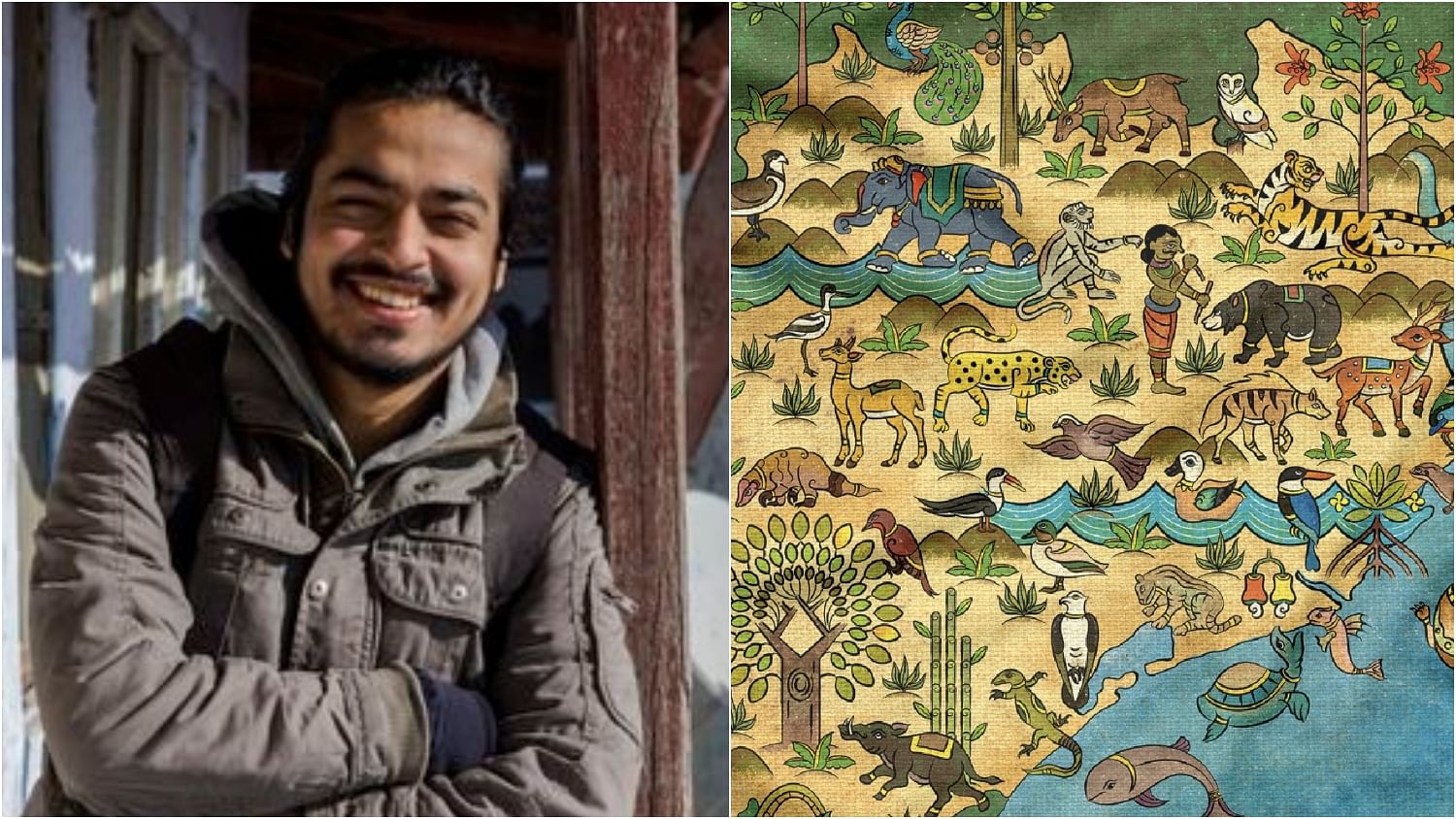
Sudarshan Shaw and his art.
Credit: X/ @Sudarshanshaw93
What started as someone’s personal project during Covid lockdown has turned into a successful tool for many state forest departments to educate the world about the wildlife of the region.
Bhubaneshwar-based graphic designer, Sudarshan Shaw, a 2016 NIFT graduate in communication design, quit his regular design job in Delhi just before Covid struck to explore his passion, ‘conservation through folk art’.
He said Covid break offered him an opportunity to plunge into it headlong.
"Conservation through folk art was my graduation project and I always knew that there was more to it than what I presented. After I returned to Bhubaneshwar, I started freelancing while simultaneously digging deeper into folk arts of various regions", said Shaw over the phone.
He said the local art is the ‘language of the land’ that crucial stakeholders of conservation projects, the tribals and locals, can read. "Folk arts of India is an age-old visual language that is native to India and hence best represents and resonates with the masses", said Shaw.
His very first attempt, a biodiversity map of Odisha, which used motifs and colours typical to Pattachitra to put together a colourful map of the different species of wildlife in Orissa, forest-dwellers and age-old beliefs, was an instant hit among the netizens.
"It was a combination of motifs and descriptions, in which colours, figures and stories are born out of our very own soil and culture. Soon, in 2021, I was approached by the Andhra Pradesh forest department to explore such a map in a visual language unique to them".
Of course, Kalamkari became the obvious choice, and Shaw chose the Srikalahasti style after much deliberation.
"It is a visual language unique to Andhra with its own interpretation of birds, animals, nature and everyday lives of people".
"So, it is apt that we use it to generate awareness about local biodiversity among the folks of the state", said Shaw.
Again, the success of the map paved the way for many more. These include elephant corridors in Tamil Nadu, Kerala and Karnataka, tiger corridors of central India, biodiversity maps of Rajasthan, West Bengal, Chhattisgarh and Gujarat.
The latest is 'The Magical Melghats', launched by Maharashtra forest department in April to mark the 50 years of Melghat tiger reserve.
Right now, Shaw is working on a map for Kanha National Park in Madhya Pradesh as well as a coffee table book exploring the biodiversity of Ladakh, which will re-imagine the techniques used in thangka art of that region.
While most of them are commissioned by either government departments or wildlife NGOs, some are also projects born out of meeting people with common goals.
For instance, for the hand-painted biodiversity map of Rajasthan, Shaw said he collaborated with a young local folk artist Rashmi Ranjan.
"It took us months to find a representation unique to Rajasthan. Finally, we settled for traditional tussar silk as base and colours prepared from natural pigments. But the colours for 50-odd species and forest habitats still posed a problem, as switching when it didn’t work – a possibility when you do digitally – is not an option when painting straight on the tussar silk. This is where local knowledge helped immensely", said Shaw.
Over time, Shaw said he developed his own visual language, inspired by folk arts, which he calls ‘Folk Indica’, to create maps and posters meant to educate people.
"Folk Indica acknowledges and celebrates the local folk arts. The contemporary twist I gave to them helps in taking this age-old vocabulary to more people", said Shaw.
Shaw also began interpreting key moments and dwindling species individually to bring more focused attention to wildlife conservation.
Worth mentioning is his ode to the tiger named fish – legendary Machhli of Ranthambore National Park in Rajasthan. In June, an unlikely battle between her and another apex predator, a mugger crocodile much larger than herself was caught on camera and added more heft to the legends surrounding this Ranthmbore rani. It is this moment Shaw chose to highlight.
"That day, the giant mugger was suffocated to death under the clutches of two tigresses. One, the smaller yet brave Machhli and the other, a much more ferocious and larger than the mugger, but who we could all see in the video, jumped in later, inspired by Machhli's courage. This was an event so rare, if not for images and videos, we may never believe this happened for real", said Shaw.
Sometimes, Shaw’s ‘conservation through folk art’ is not just about wild animals. When he digs out vanishing folk arts like that of Sorai and Khovar in Jharkhand or the traditional Aipan, a ritualistic folk art native to the Kumaon region of Uttarakhand, in a way, he is reviving the interest in these art forms too.
"Forests are now boiled down to wood that fuel the short-sighted vision of development. With vanishing forests, traditional art, wisdom and ways of forest communities too perish. This takes a toll on their sense of identity and community. This I feel we immediately need to address. And this, in a small way, is what I am doing with my art", said Shaw.